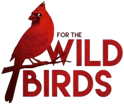Tired of seed shells or scattered seed below your bird feeding station?
Let's talk about some essentially "mess free" ways you can feed your birds!
One very common question I get (almost daily) is "How can I feed the birds while making the least amount of mess possible." So today I will share with you my most common answers.
1. Seed Cylinders--Usually when I say this people think I mean a cylindrical plastic seed tube feeder, but what I really mean is a 4-5 lb cylindrical compressed seed cake that can be put onto a seed cylinder feeder (see photo above) and in order for the birds to eat the seed they have to peck it right off the cylinder! Taking away the ability of the birds to scatter the seed everywhere, looking for that one peanut they really want. This comes in handy for the folks that live in an apartment complex or a nursing home type setting, where they would prefer you don't feed or at least feed the birds while not making a mess. The biggest benefit in my opinion is that the large cylinders last approximately 8-12 weeks before you need a refill! Making the daily or weekly job of refilling feeders way less tedious. Also great for when you travel and want to make sure your feeders don't go empty while you are away! Making you AND the birds happy!
2. Seed Cakes--This is the same concept as the Seed Cylinders except they come in small squares that would fit in a suet feeder OR large squares that measure about 7x7 that are great for putting into a Platform feeder, Tray feeder or Large Suet feeder. A lot of times when you put loose seed in these kinds of feeders a lot of the seed gets blown out by our Nebraska winds. So the cakes work amazingly to prevent that from happening.
2.5. Suet-- Suet is technically defined as the hard fat around the kidneys and loins in beef and mutton, but in common usage, most kinds of beef fat are also called suet and can safely be fed to the birds. Suet is particularly attractive to woodpeckers, nuthatches, chickadees and blue jays. Although wild birds will eat suet year round, it's most important to offer it to them in fall in winter since it's such an excellent source of energy for birds when they're burning tremendous amounts of calories just to keep warm. It is also considered nearly mess free!! There are dozens of different types of Suet feeders to choose from for this type of easy feeding bird food.
3. No Grow/Waste Seed Mixes--These mixes usually consist of the seeds you are used to feeding already, Just without the shells. The shells on the seeds are what make growing possible when they get kicked to the ground. If you cannot find a No Grow mix then you can purchase peanuts (out of the shell) and Black Oil Sunflower Hearts out of the shell and mix them together to put in any feeder that has holes large enough for the peanuts to come through! If you want to keep it even simpler than that I would suggest Medium Sunflower Hearts/Chips, as this seed is universally the most desired seed as a whole that most birds will eat!
4. My last option for a less messy feeding station would be to add trays underneath your feeders to catch the seed that spills. There are specific trays that fit a lot of seed tube feeders universally OR you can get a Songbird Essentials Seed Hoop which comes in 16" 24" and 30" and they advertise that it saves you money by catching up to 90% of spilled seed! These fit just about every feeder you can imagine.
Thank you so much for tuning in once again to hear what For The Wild Birds is suggesting for this fabulous month. See you next month. Happy Birding, Crinda Williams.

